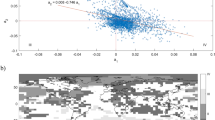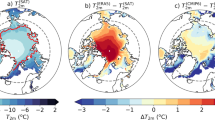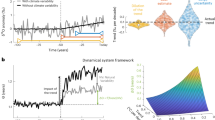Abstract
Arising from: R. G. Graversen, T. Mauritsen, M. Tjernström, E. Källén & G. Svensson Nature 451, 53–56 (2008)10.1038/nature06502; Graversen et al. reply
The vertical structure of the recent Arctic warming contains information about the processes governing Arctic climate trends. Graversen et al. argue1, on the basis of ERA-40 reanalysis2 data, that a distinct maximum in 1979–2001 warm-season (April–October) Arctic temperature trends appears around 3 km above ground. Here we show that this is due to the heterogeneous nature of the data source, which incorporates information from satellites and radiosondes. Radiosonde data alone suggest the warming was strongest near ground.
This is a preview of subscription content, access via your institution
Access options
Subscribe to this journal
Receive 51 print issues and online access
$199.00 per year
only $3.90 per issue
Buy this article
- Purchase on Springer Link
- Instant access to full article PDF
Prices may be subject to local taxes which are calculated during checkout

Similar content being viewed by others
References
Graversen, R. G., Mauritsen, T., Tjernström, M., Källén, E. & Svensson, G. Vertical structure of recent Arctic warming. Nature 451, 53–56 (2008)
Uppala, S. M. et al. The ERA-40 re-analysis. Q. J. R. Meteorol. Soc. 131, 2961–3012 (2005)
Fu, Q., Johanson, C. M., Warren, S. G. & Seidel, D. J. Contribution of stratospheric cooling to satellite-inferred tropospheric temperature trends. Nature 429, 55–58 (2004)
Mears, C. A. & Wentz, F. J. The effect of diurnal correction on satellite-derived lower tropospheric temperature. Science 309, 1548–1551 (2005)
Bromwich, D. & Wang, S.-H. Evaluation of the NCEP-NCAR and ECMWF 15- and 40-yr reanalyses using rawindsonde data from two independent Arctic field experiments. Mon. Weath. Rev. 133, 3562–3578 (2005)
Durre, I., Vose, R. & Wuertz, D. Overview of the integrated global radiosonde archive. J. Clim. 19, 53–68 (2006)
Haimberger, L. Homogenization of radiosonde temperature time series using innovation statistics. J. Clim. 20, 1377–1403 (2007)
Haimberger, L. et al. Towards elimination of the warm bias in historic radiosonde temperature records — some new results from a comprehensive intercomparison of upper air data. J. Clim. (in the press)
Author information
Authors and Affiliations
PowerPoint slides
Rights and permissions
About this article
Cite this article
Grant, A., Brönnimann, S. & Haimberger, L. Recent Arctic warming vertical structure contested. Nature 455, E2–E3 (2008). https://doi.org/10.1038/nature07257
Received:
Accepted:
Issue Date:
DOI: https://doi.org/10.1038/nature07257
This article is cited by
-
Radiative and dynamic contributions to the observed temperature trends in the Arctic winter atmosphere
Climate Dynamics (2023)
-
Winter Arctic warming and its linkage with midlatitude atmospheric circulation and associated cold extremes: The key role of meridional potential vorticity gradient
Science China Earth Sciences (2019)
-
Spring warming in Yukon mountains is not amplified by the snow albedo feedback
Scientific Reports (2018)
-
Tropospheric circulation during the early twentieth century Arctic warming
Climate Dynamics (2017)
-
The role of atmospheric heat transport and regional feedbacks in the Arctic warming at equilibrium
Climate Dynamics (2017)
Comments
By submitting a comment you agree to abide by our Terms and Community Guidelines. If you find something abusive or that does not comply with our terms or guidelines please flag it as inappropriate.



